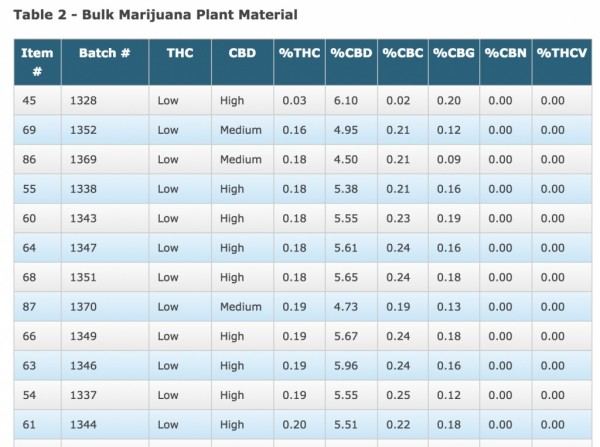indicabush
- 2,583
- 263
Curious vid at end....
This March, researchers for the United States updated the official menu of the only supplies of federally legal marijuana in the world.
The National Institute on Drug Abuse posted a revised list of the type and cost of marijuana available to researchers. You’ll need a special research permit to buy the federal government’s pot — which is grown in Mississippi — but don’t worry, you’re not missing out on anything special. Uncle Sam’s stash is largely filled with bunk.
A review of NIDA’s research marijuana menu shows the world’s top researchers have much poorer access to cutting-edge medical cannabis products than your average 18 year-old in Los Angeles or San Francisco.
Medical cannabis is legal for adults with a doctor’s note in California, and some 22 other states, and the marketplace has rapidly evolved beyond anything at the government’s lone pot farm. One in 20 California adults is estimated to have tried medical cannabis for a serious condition and 92 percent of them thought pot worked.
For example: NIDA has two main classes of pot for sale “marijuana cigarettes” and “bulk marijuana”. That’s it. Joints and kilograms. No concentrated extracts or topicals, let alone edibles, lozenges, sprays, and juices.
NIDA’s pricing schedule states that non-placebo cigarettes cost $10.96 each, placebo cigarettes cost $13.94 each, while Bulk Marijuana costs $2,497 per kilogram (2.2 pounds).
Roughly $1,200 a pound would be pretty good for wholesale bud, but the selection here is atrocious.
The highest THC cigarette the government is selling tops out at 6.7% THC. Compare that to 25% THC for pre-rolls in San Francisco and L.A. Uncle Sam has no high-cannabidiol pre-rolls, whereas high-CBD pre-rolls are common in advanced cannabis markets.
And most of the bulk marijuana is bad, too. Uncle Sam classifies cannabis that’s “low” in THC as having less than 1%, “medium” is 1-5%, “high” is 5-10%, and “very high” is greater than ten percent. Not a single government strain tests over 10.2% THC.
By comparison, the average Bay Area cannabis patient buys cannabis that’s an average of 15 percent, estimates UC Berkeley public health researcher Amanda Reiman.
NIDA also lacks high-THC-V strains, which likely hold the key to future diet drugs.
On the upside, NIDA has plenty of ultra-low-THC, high-CBD strains. Some are .53 percent THC and 13.94 percent CBD. Check out the whole list here.


This March, researchers for the United States updated the official menu of the only supplies of federally legal marijuana in the world.
The National Institute on Drug Abuse posted a revised list of the type and cost of marijuana available to researchers. You’ll need a special research permit to buy the federal government’s pot — which is grown in Mississippi — but don’t worry, you’re not missing out on anything special. Uncle Sam’s stash is largely filled with bunk.
A review of NIDA’s research marijuana menu shows the world’s top researchers have much poorer access to cutting-edge medical cannabis products than your average 18 year-old in Los Angeles or San Francisco.
Medical cannabis is legal for adults with a doctor’s note in California, and some 22 other states, and the marketplace has rapidly evolved beyond anything at the government’s lone pot farm. One in 20 California adults is estimated to have tried medical cannabis for a serious condition and 92 percent of them thought pot worked.
For example: NIDA has two main classes of pot for sale “marijuana cigarettes” and “bulk marijuana”. That’s it. Joints and kilograms. No concentrated extracts or topicals, let alone edibles, lozenges, sprays, and juices.
NIDA’s pricing schedule states that non-placebo cigarettes cost $10.96 each, placebo cigarettes cost $13.94 each, while Bulk Marijuana costs $2,497 per kilogram (2.2 pounds).
Roughly $1,200 a pound would be pretty good for wholesale bud, but the selection here is atrocious.
The highest THC cigarette the government is selling tops out at 6.7% THC. Compare that to 25% THC for pre-rolls in San Francisco and L.A. Uncle Sam has no high-cannabidiol pre-rolls, whereas high-CBD pre-rolls are common in advanced cannabis markets.
And most of the bulk marijuana is bad, too. Uncle Sam classifies cannabis that’s “low” in THC as having less than 1%, “medium” is 1-5%, “high” is 5-10%, and “very high” is greater than ten percent. Not a single government strain tests over 10.2% THC.
By comparison, the average Bay Area cannabis patient buys cannabis that’s an average of 15 percent, estimates UC Berkeley public health researcher Amanda Reiman.
NIDA also lacks high-THC-V strains, which likely hold the key to future diet drugs.
On the upside, NIDA has plenty of ultra-low-THC, high-CBD strains. Some are .53 percent THC and 13.94 percent CBD. Check out the whole list here.







